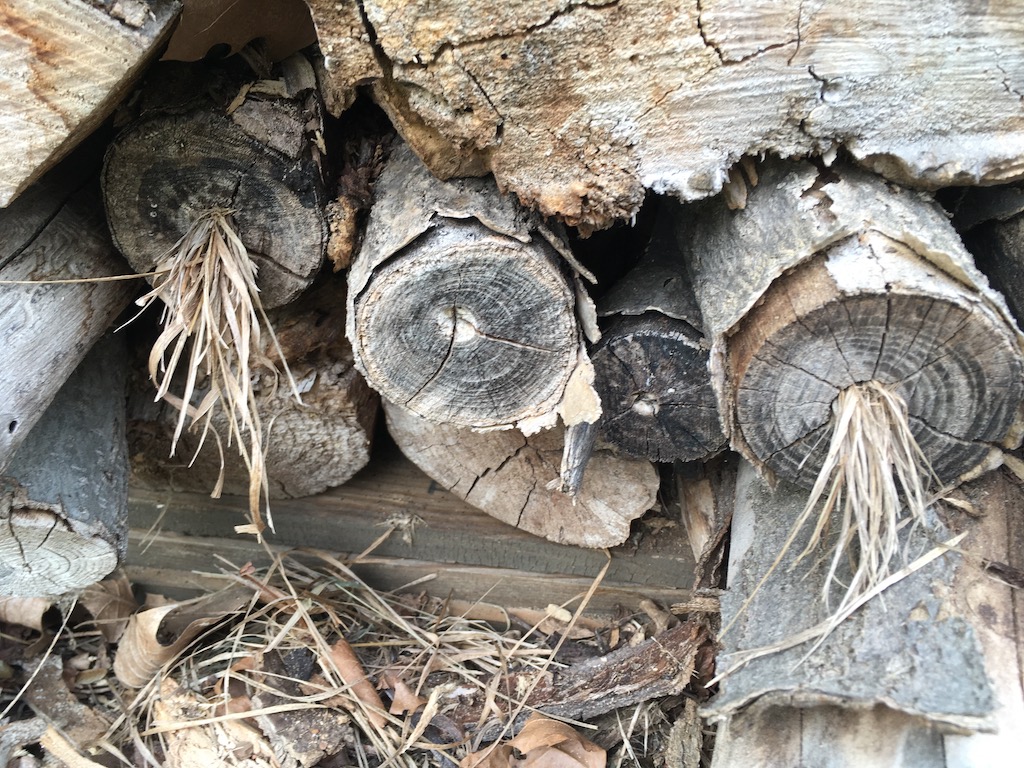As I sat outside one late summer day, I noticed something that seemed strange. A blade of dry grass seemed to be flying around, purposefully, as if it were looking for a place to land.
I had to see this a couple of times before it registered. The first time, one can assume that somehow some poor insect has become entangled with it, and will shake it off soon. But after seeing it more than once, it becomes clear that the insect must be doing it on purpose.
So the next time I saw this happen, I followed it to see where it was going. After meandering around a bit, it finally began hovering around a little hole in the end of one of the logs I had stacked for firewood. It landed at the edge of the hole, and then walked in, dragging the grass behind it.
Okay, so this is a nest-making activity of some kind. But I had never heard of an insect that stuffs grass into logs.
That was the day I became acquainted with what is aptly named the grass-carrying wasp.
I have a lot of firewood, for someone with no fireplace. It’s part of owning fifteen acres and a chainsaw. The emerald ash borer, and whatever similar boring worm that has been killing red pines in Michigan, has seen to it that dead trees regularly fall, sometimes taking other trees such as cottonwood or sumac with them. I have also electively carried out a vendetta against aggressive invasives such as Autumn Olive, Amur honeysuckle and Tree of Heaven.
Often, the trees that fall will have already been colonized by black carpenter ants or carpenter bees, who have abandoned their cavities by the time I get there with the chainsaw. As the logs get cut and stacked, this exposes a lot of little round holes in the ends of the logs, some of which happen to be the perfect size for solitary insects such as mason bees. The fact that I can only destroy these logs when I have the occasional bonfire means that this habitat may be available for years, especially near the bottom of the stack. No, I don’t rotate my firewood.

The grass-carrying wasp has a life cycle much like that of the mason bee. During the summer it feeds on nectar and possibly small insects. As fall approaches, it turns its attention to finding a suitable hole, and dragging grass into it to make a nest. The grass is formed into individual cells, which are then provisioned with young grasshoppers or crickets which have been paralyzed by its sting. Eggs are laid, and the larvae feed on the grasshoppers. They will also feed on each other if given the opportunity. After this messy and somewhat disturbing incubation process, which only the results-oriented process of evolution could have “designed,” some of the offspring survive to claw their way out of the grass-stuffed hole, and live.

I have not yet figured out how the wasp carries the last piece of grass into the hole. At the time I was observing, it was in the habit of dragging the grass behind it, never pushing it. How does it get out of the hole after the last piece is in? Maybe it doesn’t. The articles I read said that the wasp “dies” after the nestmaking is complete, but they didn’t elaborate on exactly how it meets its death. Perhaps, it stuffs blades of grass into the hole until it can’t get out to find another one, and then recognizes the opportunity to take a cozy little nap, from which it never wakes.
So if you see logs in your wood pile that seem to have grown a winter mustache, don’t burn them. You’ve provided habitat for an important and increasingly rare pollinator that needs all the help it can get.



One Comment
Pingback: